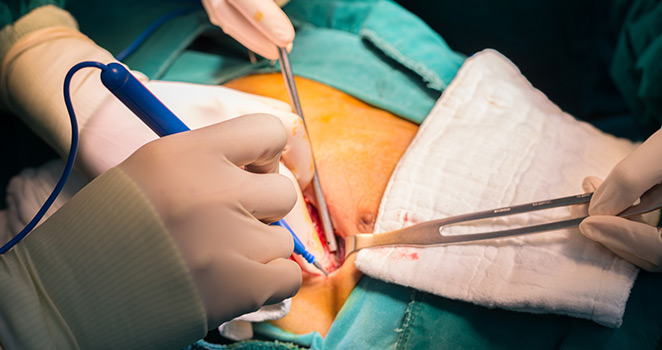Atrium Health Navicent Heart & Vascular Care
Thoracotomy

A thoracotomy is a surgical procedure used to open the chest wall. A thoracotomy can be performed on the left, right, or in the center of the chest.
The four types of procedures performed during a thoracotomy are:
- Lobectomy
- Pneumonectomy
- Wedge Resection
- Segmentectomy
Lobectomy
A lobectomy is typically performed when there is an issue found in one of the lobes of the lung. The incision for this procedure reaches around the front of the chest below the nipples to under the shoulder blade in the back.
Pneumonectomy
A pneumonectomy is the removal of the entire lung. This procedure is often used to treat certain forms of lung cancer, tuberculosis, and chronic obstructive pulmonary disease. The most common types of pneumonectomies are the standard and extrapleural pneumonectomy.
Wedge Resection
A Wedge resection is a minimally invasive procedure that removes cancerous tissue along with surrounding healthy tissue.
Segmentectomy
This procedure extracts more of the lung than a wedge resection without removing the entire lobe.
Reasons a thoracotomy procedure may be needed:
- To treat breathing issues
- To diagnose a disease in the lungs or chest
- To remove blood clots, lymph nodes or tumors
- Pus removal from the chest
- To treat collapsed lung tissue occurring from injury or disease
- Removing lung or heart vessels or to repair the heart
An individual is placed in the intensive care unit after a thoracotomy procedure for close monitoring. The average hospital stay after this procedure is 5 to 10 days, depending on if any complications should arise. Complications related to this procedure include:
- Infection
- Collapsed lung
- Bleeding
- Adverse reaction to anesthesia
- Gas or air collecting in the chest
- Damaged organs in the chest
- Chronic pain syndrome in the incised area
Patients who are obese or smoke may have an increased risk of developing these complications. Other factors that could increase risk are a previous heart attack or stroke, injury to more than one body part, previously receiving radiation or having other chronic medical conditions.
Post-procedure Methods
Hospital
Tubes and IV lines are placed in the body to help the patient breathe, urinate and receive nutrition. Antibiotics and other medications are also given immediately after surgery to assist recovery. An incentive spirometer also may be used to clear the lungs during coughing.
Home
A surgeon thoroughly reviews the required aftercare methods and risk of complications before discharge. It is the patients responsibility to regain strength without inhibiting healing. Incisions may itch, be sore and contain bruising in the weeks after the surgery, so it should be washed gently with warm water and mild, fragrance-free soap.
Airborne irritants in the home should be removed via ventilation, and chemical irritants, smoke, and germs should be avoided.
It is important for a patient to start being mobile to improve strength, circulation, and lung capacity. Rigorous activities should be avoided, but moderate walks should be incorporated into the recovery plan. Pain medications taken before any type of exercise activities reduces the shortness of breath that is typical during a thoracotomy.
A doctor should be alerted right away any if these symptoms appear:
- Staples or stitches coming apart
- Excessive bleeding
- Off-colored or bloody mucus
- Severe vomiting
- Difficulty breathing
- New and persistent pains in the surgery area
- Fever and chills
- Pus, blood and discharge at the incision site
As always, call 911 in the case of medical emergencies.